
|
Geological Survey Bulletin 1291
The Geologic Story of the Uinta Mountains |
GEOLOGIC STRUCTURE
STRUCTURAL geology deals with the relations of rock masses to one another, particularly insofar as the rocks have been deformed by forces within the earth. Studying the geologic structure helps the geologist unravel the history of the earth.
Most of the early-day geologists who visited the Uinta Mountains commented on the unusual structural relation of the range to its neighbors. Trending due east 150 miles from the little town of Kamas, the range is directly athwart the northerly trend of the neighboring ranges and uplifts of the Rocky Mountains. The crestline of the Uinta Mountains actually is broadly arcuate, trending about N. 10° L. from Kamas to about the center of the range near the Burro Peaks, then swinging gradually east-southeastward to its eastern terminus near the Little Snake River. Structurally and topographically, the Uinta Mountains intersect the north-trending Wasatch Range on the west at an abrupt 90° angle.
On the east, however, the trend of the Uinta Mountains veers to the southeast and merges with the northwest-trending folds of the White River Plateau and the Park Range. All the major structural trends in that part of the Rocky Mountains and the adjacent Colorado Plateau, for that matter, are northwest, including most major faults. So, the only really major discordance of the Uinta Mountains is along the west margin of the Rocky Mountains, particularly at the Wasatch juncture (fig. 53).
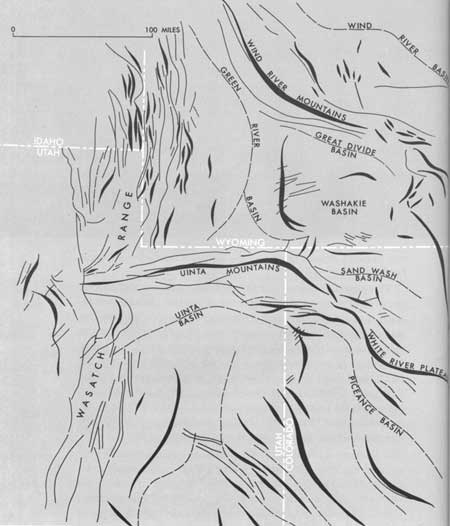
|
| STRUCTURAL "GRAIN" of the region surrounding the Uinta Mountains, much generalized. The Uinta trend intersects the Wasatch trend (left) at a 90° angle but merges concordantly with the northwesterly trends to the east. Axes of anticlines and uplifts, spindle-shaped patterns; axes of syncline and basins, dashed lines; faults, solid lines. (Fig. 53) |
In trying to visualize the crustal movements that produced the Rocky Mountains 60-70 million years ago, one is bemused by the magnitude of the uplifting forces that raised thousands of cubic miles of rock in the Uinta Mountains alone from a position near or even below sea level to present altitudes, thousands of feet higher. If the strata that have been eroded from the Uinta Mountains were restored in our imagination, the upper layers would be 30,000-40,000 feet above sea level. This is not to say that the mountains ever stood that high, even though some early-day geologists surmized that they did. For as the mountains rose, erosion attacked and carried away the heights, and the higher the mountains rose, the more vigorous the attack. It is doubtful that the mountains were ever really much higher than now—possibly a few thousand feet higher, but never Himalayan, certainly, in size.
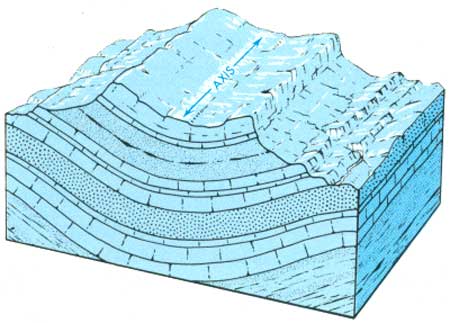
An eroded syncline
The upbuckling that produced the mountains was accompanied by comparable downbuckling under the basins. As the mountains rose, the basins subsided, so that deposits once near sea level throughout the region are now 12,000-13,000 feet high in the mountains but are as much as 30,000 feet below sea level beneath the Green River and Uinta Basins. Moreover, debris shed from the mountains accumulated in the adjacent basins, and its added weight further depressed the basin floors. Obviously, the crust is not unyielding; it responds to pressures directed horizontally, vertically, or obliquely. Such pressures—building up at the end of the Cretaceous Period—caused the crustal movements that produced the Uinta Mountains.
Folds
In the High Uintas, the crestline is much closer to the north flank than to the south. The marked asymmetry of the range is related to the structure of the underlying bedrock. In brief, the Uinta Mountains are carved from an immense anticlinal fold whose outline closely coincides with the outer limits of the mountains. The uplifted strata of the range, therefore, slope outward from the crest of the fold toward the flanks, so that successively younger rocks are crossed as one travels outward from the interior of the range toward the flanks (fig. 54). The Uinta anticline is compound in that its crest has two main apexes or culminations—one in the Western Uinta Mountains and one in the Eastern Uintas—something like two peanuts in one shell. In a general way, however, the crest of the fold is nearly flat, so that the bedding or stratification along the crest is almost horizontal, from Mount Watson on the Provo-Weber divide all the way to Douglas Mountain near the east end of the range. Away from the fold axis the dip of the strata steepens, first gradually, then abruptly toward the flanks (figs. 55 and 56).
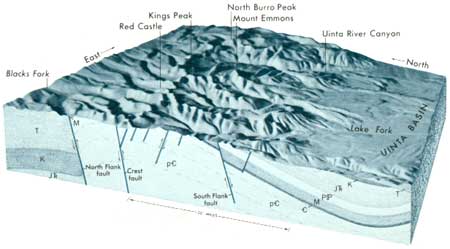
|
| GEOLOGIC CROSS SECTION through the Western Uinta Mountains. pC Precambrian rocks; C, Cambrian; M, Mississippian; PP, Permian and Pennsylvanian; JTr, Jurassic and Triassic; K, Cretaceous; T, Tertiary. Compare with figure 58. Vertical scale X2. (Fig. 54) |

|
| FLAT-LYING STRATA in the Uinta Mountain Group (Precambrian) at crest of Uinta Mountains, accentuated by an early August snowfall. Wilson Peak, altitude 13,053 feet. (Fig. 55) |
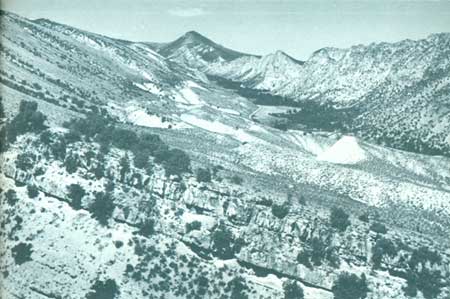
|
| DIPPING STRATA, north flank of Uinta Mountains at Sheep Creek Canyon. Dipslopes and cliffs in foreground are eroded from the Park City Formation (Fig. 56) |
Like the mountains themselves, the Uinta anticline is asymmetrical. Its crest is much closer to the north flank than to the south; therefore, the strata on the north flank dip more steeply than the strata on the south. Severe bending along the flanks moreover, has led to rupture and large-scale faulting, particularly along the north flank.
In the west half of the range, the crest of the anticline very nearly coincides with the crest of the range in some places it is slightly north, in others, slightly south. Thus, despite the removal of many thousands of feet of rock by erosion, the position of the main divide apparently has remained almost unchanged since the fold came into being 70-odd million years ago.
Figure 57 is a generalized map of the Uinta anticline; in detail the anticline is more complex. Elongate east and west domes share a common axis, or crestline, which curves gently to the north in a broad arc. The east and west domes are almost mirror images of each other—comparable in size and shape—although the east dome is appreciably more complex than the west. Each dome is 70-75 miles long and 30-35 miles across. Both are faulted internally, and both are partly bounded by faults.
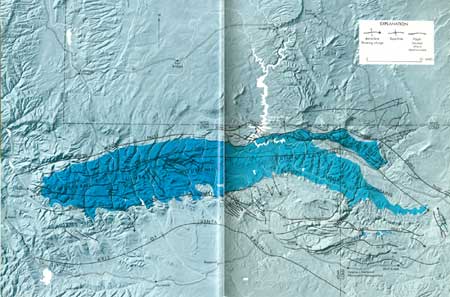
|
| GENERALIZED STRUCTURE MAP of the Uinta Mountains. Darker tint indicates Precambrian core of the range. (click on image for an enlargement in a new window) (Fig. 57) |
Associated with the east dome, but not the west, are several large subsidiary folds, known since the time of Powell; they include the Blue Mountain, Split Mountain, and Section Ridge anticlines and their synclinal counterparts. These are shown in figure 58. In addition, there are many smaller folds, a few miles long, on the flanks of the larger ones. Most of these have been actively prospected for petroleum, and among them are several economically important oil fields, the most significant recent discovery being that of the Bridger Lake field, just west of Henrys Fork, high on the north flank. Bedrock at Bridger Lake is concealed by thick glacial deposits, and the oil field was discovered by purely geophysical means. Its discovery in 1965 set off a flurry of exploration and leasing activity that is still in progress.
Faults
Mention has been made of the asymmetry of the Uinta anticline. The crest of the fold is much nearer the north flank than the south; consequently, the strata slope, or dip, more steeply down the north limb of the fold than down the south (figs. 54 and 58). To a large extent, bending on the north limb proceeded to the point of rupture. Even solid rock will yield to long-sustained stress. As the folding progressed, the strata were first tilted, then overturned, and, finally, broken. Deep crustal movements pushed the Uinta anticline northward over the margin of the Green River Basin, causing the development of three large faults: the North Flank fault to the west, the Henrys Fork fault at the center, and the Uinta fault to the east. These are reverse, or "thrust," faults, the fault surfaces dip steeply under the mountains, and the upthrust, mountainward block overrides the basinward block. Of the three faults, the Uinta appears to be the largest, having a displacement of about 34,000 feet, or the distance one block moved past the other. The North Flank fault may have a displacement of as much as 25,000 feet; the Henrys Fork fault, perhaps more than 12,000 feet.
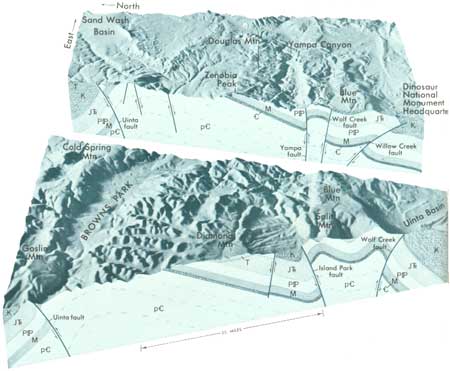
|
| GEOLOGIC CROSS SECTIONS through the Eastern Uinta Mountains. pC, Precambrian rocks; C, Cambrian; M, Mississippian; PP, Permian and Pennsylvanian; JTr, Jurassic and Triassic; K, Cretaceous; T, Tertiary. Note that Cambrian rocks are missing from the north flank. Vertical scale X2. (Fig. 58) |
Large faults also broke the south limb of the anticline, although none of these appears to have displaced the strata as much as those on the north limb. From west to east, they include the South Flank fault, extending 80 miles east from the Duchesne River area to Ashley Creek, the Deep Creek fault zone northwest of Vernal, and the Willow Creek, Island Park, Mitten Park, Wolf Creek, and Yampa faults of Dinosaur National Monument. These faults have generally been regarded as "normal faults," faults in which the surface of rupture slopes under the downdropped block. Recent studies by several investigators, however, suggest that some of them are "reverse" faults, at least at depth. In other words, the mountainward, upthrown side moved up and over the basinward, downthrown side. In the cross sections (figs. 54 and 58) the Yampa, Island Park, Wolf Creek, and Willow Creek faults are shown as reverse faults; the South Flank fault is shown as a normal fault.
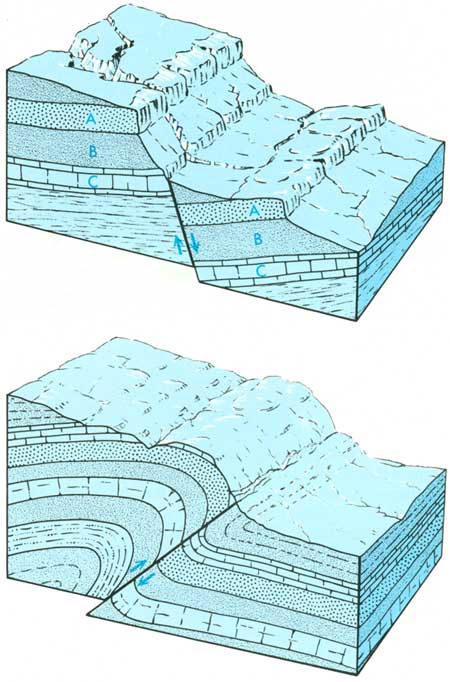
A normal fault, showing repetition of strata
(top). A reverse fault, showing "drag" (bottom).
Most of the large faults of the Uinta Mountains are fairly broad zones of disturbance rather than simple fractures. There is much ground-up and shattered rock, much distortion, and many subsidiary fractures. The Uinta fault, largest in the range, serves to illustrate.
The Uinta fault was named and first described by Powell (1876, p. 177). A more detailed description can be found in U.S. Geological Survey Professional Paper 490 (Hansen, 1965). The fault is well exposed and readily accessible; the best places to see it are just north of the town of Dutch John and just south of Clay Basin. Figure 59 shows the fault at Hideout Canyon, before Flaming Gorge Dam was built. From its terminus southwest of Manila, the Uinta fault trends sinuously east-northeast for about 45 miles as a continuous fracture. It increases in displacement and width to about the 109th Meridian, where it passes beneath the Browns Park Formation. About 10 miles to the east, it emerges as the Sparks fault and is virtually continuous for another 20 miles. Discontinuous fractures extend at least another 30 miles.
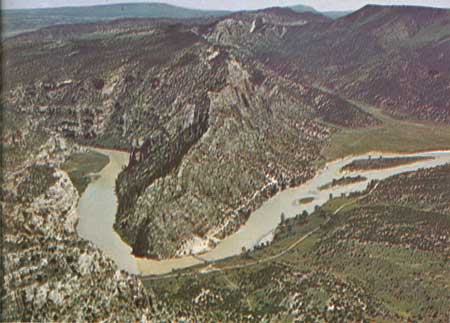
|
| UINTA FAULT from rim of Hideout Canyon. Weber Sandstone (left and center), is upturned against Uinta Mountain Group. (Fig. 59) |
The Uinta fault has many subsidiary branches. It also contains large slices of rock torn from the walls and dragged into the fault zone. One such slice north of Dutch John is more than 2 miles long—possibly 3 miles—and as much as 400 feet across. Well back from the fault surface the strata have been tilted up on edge and even overturned, but where Tertiary rocks are involved, they are little deformed despite the severe deformation in the immediately underlying Cretaceous rocks. Apparently, the fault had more than one period of movement: the first and strongest movement in Late Cretaceous or earliest Tertiary time severely dislocated the involved rocks; a second movement, after the Tertiary rocks had been deposited across the fault, simply sheared off the Tertiary strata with little other effect. Still later, gravitative movements accompanied the collapse of the Eastern Uinta Mountains (p. 62 and 104).
Some further mention must be made of the faults of Dinosaur National Monument. These faults are especially significant for their dramatic physical expression and for the part they had, therefore, in shaping the impressive local scene. Few faults anywhere are better displayed. All of them happen to be eroded to levels in the earth's crust where contrasting strata help disclose their geometric form. Thus, between Round Top Mountain and Echo Park in the heart of the monument, the Weber Sandstone is repeated topographically in four huge escarpments, or stairsteps, bounded from rim to river by the Yampa, Red Rock, and Mitten Park faults and the canyon of the Yampa River itself. The fault relations are unmistakably clear.
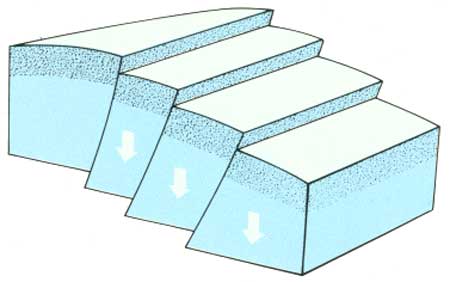
Strata repeated by stair-step faulting
The faults of the Dinosaur National Monument area further disclose sharp flexing of the strata in their walls, again dramatically exposed (fig. 60). Like an expression of frozen movement, or of time standing still, these faults accent the grandeur of the scene and stir wonder in the heart of the viewer. Even the most languid boater, lazing in the hot summer sun, is duly awed as he floats past the Mitten Park and Island Park faults, upstream and down, respectively, from Whirlpool Canyon.

|
| SHARPLY DRAGGED STRATA along the Mitten Park fault below Harpers Corner. Red Moenkopi Formation in foreground is downdropped against folded Weber Sandstone in background. (Fig. 60) |
Internally, the Uinta Mountains are also extensively faulted, and few large expanses of rock can be seen that do not have some faulting. Two major zones are especially noteworthy. One zone named the Crest fault by J. D. Forrester (1937, p. 645), extends west to east for many miles along the west dome of the anticline just north of the crest (fig. 61). Recent mapping by Crittenden, Wallace, and Sheridan (1967, plate 1) showed that the Crest fault is a complex zone of many interrelated fractures with various trends and offsets. Neither the total displacement nor the direction of movement is known with certainty, although the north side of the zone, according to Crittenden, Wallace, and Sheridan probably has dropped about 2,000 feet.
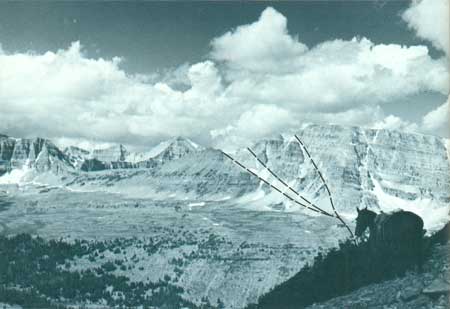
|
| CREST FAULT, a zone of fractures, viewed from the head of Backs Fork of the Green River. Note flat strata (left of fault zone) and dipping strata (right). Photograph by Max D. Crittenden, Jr. (Fig. 61) |
The other zone extends along the east dome of the anticline, also north of the crest, from the vicinity of Red Canyon to Browns Park, and to the east end of Cold Spring Mountain. This fault zone was instrumental in the collapse of the east end of the Uinta Mountains in Tertiary time. Augmented by gravitative movements on the Uinta fault to the north, and in concert with movement on the Yampa fault to the south, it led to the collapse of the Uinta Mountain "graben," noted on page 62. In summary, the crestal part of the east dome collapsed under gravity relative to the flanks of the dome some time after compressive mountain building had ended. When the compressional forces that arched up the dome relaxed, gravity began to pull the dome back down. Total collapse along the crestline amounted to about 4,500 feet and, thus, accounts for most of the difference in altitude between the east and west halves of the range (Hansen, 1965, p. 172).
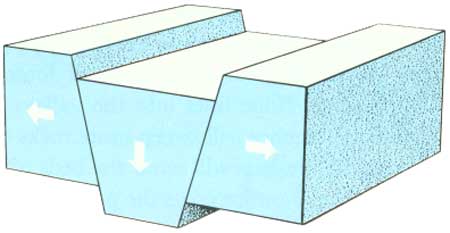
A simple graben formed by tension
Crustal warping
Gravitative movements of the earth's crust began in the Uinta Mountains before the Browns Park Formation was deposited, even before the Gilbert Peak erosion surface was cut. These movements continued until after deposition of the Browns Park Formation was completed. Along the north side of Browns Park the strata were fractured, tilted, and dragged into near-vertical attitudes. Locally, they were even overturned, as in Jesse Ewing Canyon, near the west end of Browns Park. Elsewhere, collapse was accompanied by large-scale regional tilting of the ground surface, clearly shown by deformation of the Gilbert Peak erosion surface on the north flank of the range (fig. 62), by tilting of correlative surfaces on the south flank, and by tilting of strata, such as the Browns Park Formation. Partly bounded by faults, different areas were tilted in different directions. But the tilting on the north flank was predominantly inward toward the south, and on the south flank, predominantly inward toward the north, just as one would expect of a foundering mountain range.
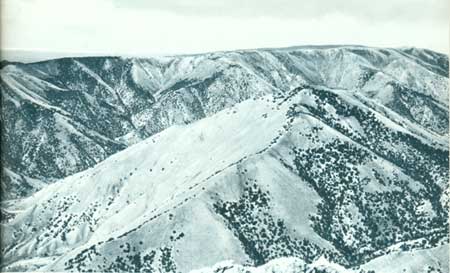
|
| GOSLIN MOUNTAIN. A tilted remnant of the Gilbert Peak erosion surface on the north flank of the range. Now sloping southward (left), it formerly sloped northward. (Fig. 62) |
Quaternary crustal movements
How long warping and faulting continued in the Uinta Mountains after the Browns Park Formation was deposited is unknown, although both processes clearly extended into the Quaternary Period and may still be in progress. Little direct evidence of Quaternary deformation has been observed, but careful search perhaps would disclose more.
Some evidence is available in Lodore Canyon. After the Green River had entrenched itself 1,500 feet or so into Lodore Canyon, it apparently stopped cutting downward and began to widen its valley. But the river was then rejuvenated, and it resumed cutting downward an additional 600-800 feet to its present depth. Thus was formed the two-tiered valley, shown in profile (p. 48). Although the cause of rejuvenation is unclear, renewed uplift is suspect, and it might have happened in Quaternary time. Canyon profiles suggest similar rejuvenation upstream in Red Canyon, but the evidence is not compelling.
In the Uinta Basin at Towanta Flat, just south of the mountain front and just west of Lake Fork (fig. 63), local but clear-cut deformation occurred in late Pleistocene time. A graben and several subordinate fault scarps more than 3 miles long displace what probably are Bull Lake age (late Pleistocene) glacial-outwash terraces, but the faults do not cut across younger terraces or moraines of Pinedale age. One of the fault scarps is about 40 feet high.
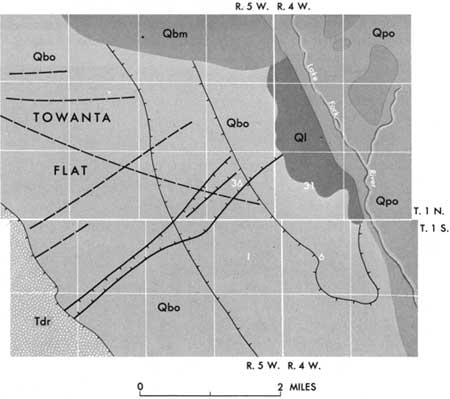
|
| QUATERNARY FAULTS (heavy lines) cutting glacial outwash, south of Uinta Mountains. Prominent scarps, heavy hachured lines; subdued fault traces, heavy dashed lines; terrace margins, light hachured lines. Tdr, Duchesne River Formation; Qbm, moraine of Bull Lake age; Qbo, outwash of Bull Lake age; Qpo, outwash of Pinedale age; Ql landslide. (Fig. 63) |
On the north flank of the range just north of Phil Pico Mountain a probable faulted alluvial fan was noticed by Max Crittenden, Jr. (oral communication, 1968), on aerial photographs. The age of this feature is uncertain, but it probably is no younger than the Bull Lake Glaciation.
On the Middle Fork of Blacks Fork just south of the North Flank fault are the remains of a spectacular rock-fall avalanche. Thousands of tons of rock, now spread over an area of perhaps 100 acres, broke free from the tilted outcrop of the Mississippian limestone and plummeted 1,000 feet to the canyon floor. There, part of the rock avalanche crossed the Middle Fork and traveled 200 feet up the opposite canyon wall. Just when this event happened is unknown, but the evidence is very fresh, and it must have happened in the not-too-distant past—a few hundred years ago, at most. Although the avalanche might have been released by gravity alone, it is the sort of feature that commonly is associated with earthquakes, such as the 1959 Madison River slide in Montana. Because of nearness of the avalanche to the North Flank fault, its release could easily be ascribed to geologically recent activity on the North Flank fault.
Historically, however, the Uinta Mountains have been seismically quiet, even though many earthquakes are recorded annually in the Wasatch Range to the west. But the historic period has been too short geologically to permit valid projections of events in the Uinta Mountains, either into the past or into the future.
| <<< Previous | <<< Contents >>> | Next >>> |
bul/1291/sec4.htm
Last Updated: 18-Jan-2007